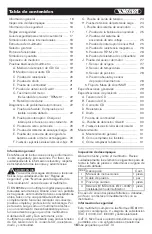
Multimeter Basic Testing
5
The measurement ranges of DC current are:
200.0mA and 10.00A.
To measure current, do the following:
1. Turn off power to the circuit. Discharge all
highvoltage capacitors.
2. Insert the red test lead into the mA or 10A
terminal and the black test lead into the COM
terminal.
3. Set the rotary switch to an appropriate
measurement position in A .
4. Break the current path to be tested. Connect the
red test lead to the more positive side of the
break and the black test lead to the more negative
side of the break.
5. Turn on power to the circuit. The measured value
shows on the display.
Note
• If
the value of current to be measured is unknown,
use the maximum measurement position (10A)
and 10A terminal, and reduce the range step by
step until a satisfactory reading is obtained.
• When
DC current measurement has been
completed, disconnect the connection between
the testing leads and the circuit under test.
• At
10A Range: for continuous measurement
10 seconds and interval time between 2
measurements greater than 15 minutes.
C. Resistance Testing
(see figure 5)
D. Diode Testing
(see figure 6)
To avoid damages to the multimeter or to the
devices under test, disconnect circuit power and
discharge all the high-voltage capacitors before
measuring resistance.
To avoid possible damage to the multimeter
and to the device under test, disconnect circuit
power and discharge all high-voltage capacitors
before testing diodes and continuity.
WARNING
WARNING
figure 5
figure 6
Never attempt an in-circuit current measurement
where the open circuit voltage between terminals
and ground is greater than 60V DC or 30V AC rms.
The resistance ranges are: 200.0
Ω
, 2.000k
Ω
,
20.00k
Ω
, 200.0k
Ω
, 2.000M
Ω
and 20.00M
Ω
.
To measure resistance, connect the multimeter as
follows:
1. Insert the red test lead into the
Ω
terminal and the
black test lead into the COM terminal.
Never attempt an in-circuit current measurement
where the open circuit voltage between terminals
and ground is greater than 60V DC or 30V AC rms.
Use the diode test to check diodes, transistors, and
other semiconductor devices. The diode test sends
a current through the semiconductor junction, then
measures the voltage drop across the junction. A
good silicon junction drops between 0.5V and 0.8V.
2. Set the rotary switch to an appropriate
measurement position in
Ω
range.
3. Connect the test leads across with the object
being measured. The measured value shows on
the display.
Note
• The
test leads can add 0.1
Ω
to 0.2
Ω
of error to
the resistance measurement. To obtain precision
readings in low-resistance, that is the range of
200
Ω
, short-circuit the input terminals beforehand
and record the reading obtained (called this
reading as X). (X) is the additional resistance from
the test lead. Then use the equation: measured
resistance value (Y) – (X) = precision readings of
resistance.
• When
the resistance reading 0.5
Ω
in the
short-circuit condition, please check for loose test
leads or other reasons.
• For
high resistance (>1M
Ω
), it is normal taking
several seconds to obtain a stable reading, and it
is better to choose shorter test lead.
• When
there is no input, for example in open
circuit condition, the multimeter displays “1”.
• When
resistance measurement has been
completed, disconnect the connection between
the testing leads and the circuit under test.
Summary of Contents for KN 8056
Page 1: ...KN 8056 Digital automotive multimeter Mult metro digital automotriz...
Page 33: ...Notes Notas...
Page 34: ...www knova com mx...







































